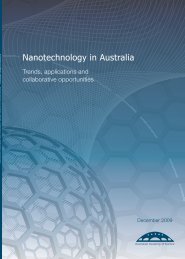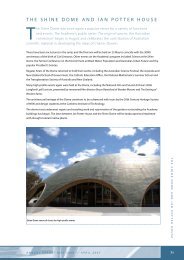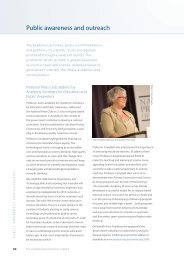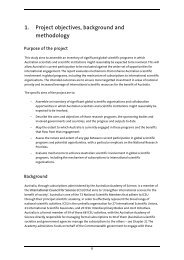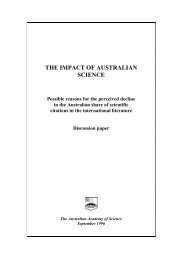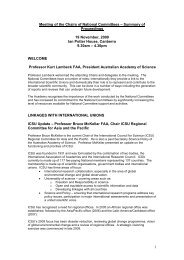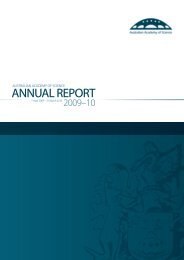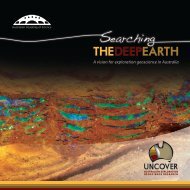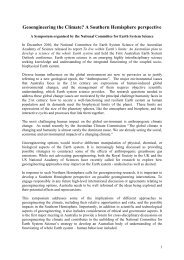Australia's Major National Research Facilities - Australian Academy ...
Australia's Major National Research Facilities - Australian Academy ...
Australia's Major National Research Facilities - Australian Academy ...
Create successful ePaper yourself
Turn your PDF publications into a flip-book with our unique Google optimized e-Paper software.
<strong>Research</strong> School of Physical Sciences and Engineering. EME personnel use the latter for elastic recoil detection and perturbed angular<br />
correlation studies. Synchrotrons and storage rings around the world are also used by EME personnel to determine both the electronic<br />
and structural properties of materials.<br />
Semiconductor Nanofabrication Facility (UNSW)<br />
The Semiconductor Nanofabrication Facility (SNF) at UNSW provides an <strong>Australian</strong> capability for the fabrication of advanced<br />
nanoscale semiconductor devices and their integration with microelectronics. SNF is a key facility of the Centre for Quantum<br />
Computer Technology, an <strong>Australian</strong> <strong>Research</strong> Council Special <strong>Research</strong> Centre.<br />
<strong>Australian</strong> International Gravitational Observatory (AIGO)<br />
AIGO has been planned for more than 10 years, and since 1999 has been under active development. It was identified in the<br />
Decadal Review of Astronomy in 1995, and will be a significant component of the next decadal review. The project has been<br />
led by the <strong>Australian</strong> Consortium for Gravitational Astronomy, with core universities, UWA, ANU, and UofA. The AIGO<br />
research facility has been developed on a specially designated site 80km north of Perth, operated by UWA. Total investment<br />
in the facility and associated university facilities exceeds $29M, including major corporate donations towards AIGO’s public<br />
education centre, the Gravity Discovery Centre. Through the <strong>Australian</strong> activity, CSIRO Centre for Optical Technology won<br />
the contract for major optical fabrication for the US LIGO project.<br />
The original proposal for AIGO was for a $30m project (more than 10 years ago) Today it is perhaps surprising to see that the<br />
total investment in AIGO, including the associated Public Outreach approaches this amount. The additional funds required to<br />
build the long arm instrument will bring the total project cost to ~$50M, which is not unreasonable compared to LIGO and<br />
VIRGO, especially when issues such as low university overheads are taken into account.<br />
Like all major facilities, AIGO offers the opportunity both to spawn new industries and to support major industrial development. AIGO<br />
is a currently a <strong>National</strong> Facility in all but name. Five universities have been actively participating in research at AIGO. AIGO is not a<br />
service provider (such as a synchrotron) and is never likely to be one. Rather, it is an international research project at the frontiers of<br />
science and technology. Its research program is strongly linked to the US LIGO project and is supervised by an international advisory<br />
committee . For facilities such as AIGO it is not appropriate to consider funding it on a user pays principle. Observatories are long-lived<br />
facilities. AIGO is likely to require moderate recurrent funding over a long period of time, and like all observatories is never likely to be<br />
commercially viable. The WA Government has announced a Centre of Excellence in Gravitational Astronomy which will provide<br />
academic support for AIGO.<br />
The development of AIGO is strongly supported by the international community. AIGO already participates in collaborative research<br />
with all the other major international projects. <strong>Major</strong> components of AIGO have to date been donated or loaned by other projects and<br />
similar in kind contributions can be expected for the next stage of development. At this stage it is unlikely that the capital costs for<br />
AIGO will be provided by other countries.<br />
Much of the development of AIGO to date was funded through Systemic Infrastructure as the first half of a 5 year<br />
collaboration and partnership program with the US LIGO project.<br />
(IV) Range $5-10 Million<br />
30



